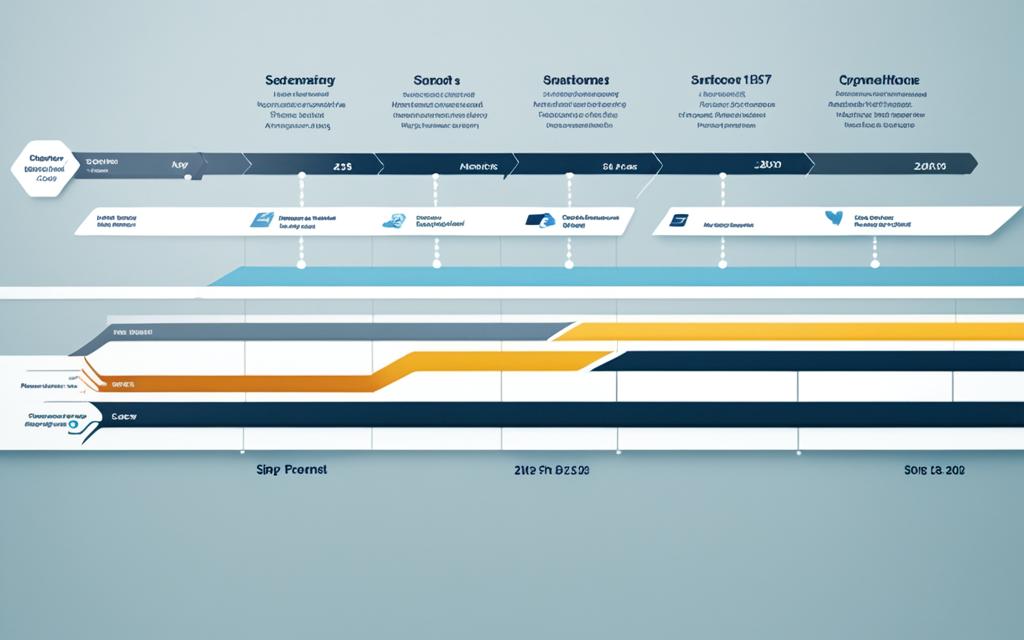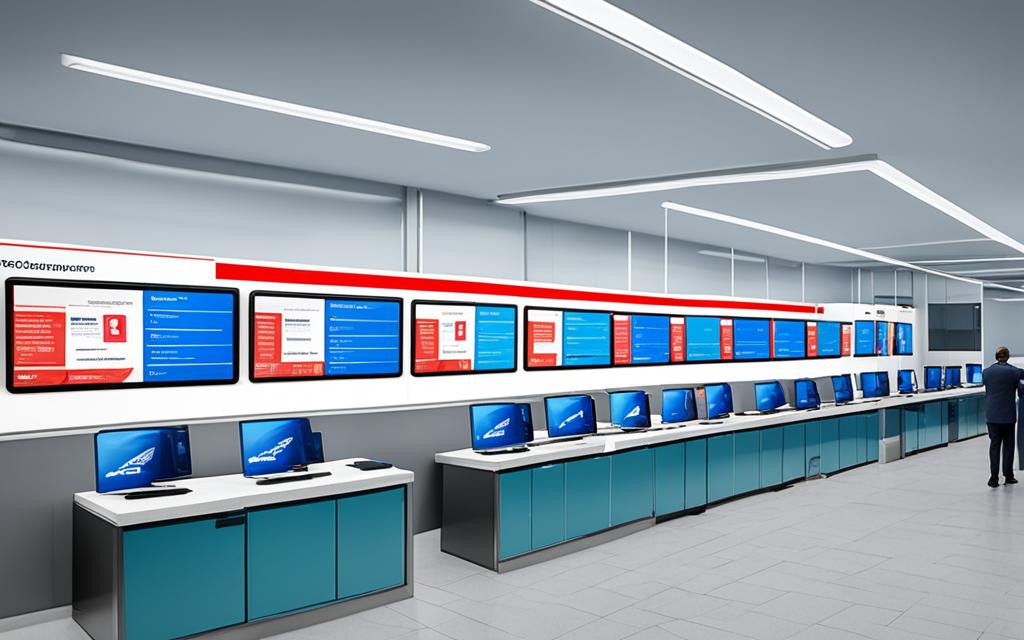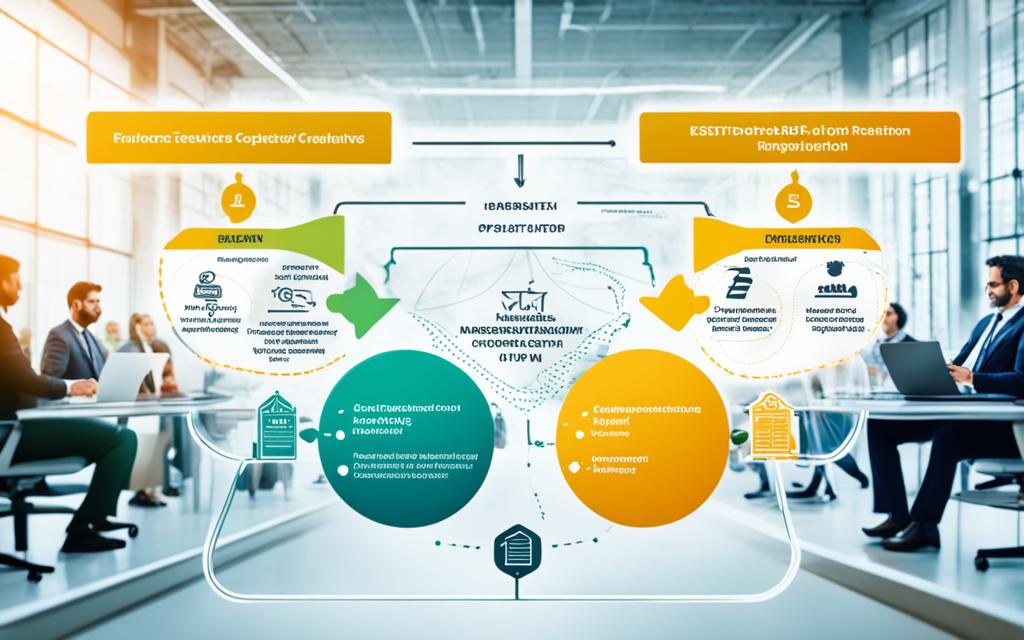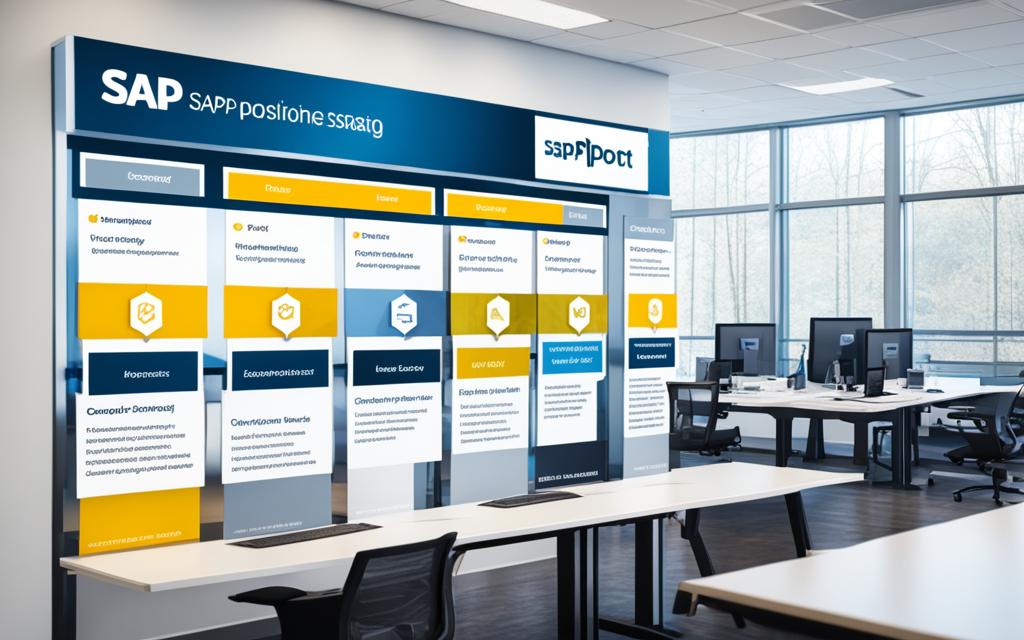Have you ever thought about how SAP CO could change your company’s financial controlling? I’m diving into the key role of SAP CO in SAP Systems. It’s vital for improving management practices. SAP CO offers many features that help with financial reporting, cost accounting, and making better decisions.
Mastering SAP CO is key to reaching your business goals. I’ll show you why it’s not just good to know SAP CO; it’s essential.
Key Takeaways
- SAP CO is key to good financial controlling and management.
- Knowing its parts helps in making management better.
- Being good at SAP CO makes financial reporting more efficient.
- It helps in making better decisions.
- It helps in reaching strategic business goals.
Understanding SAP CO and Its Importance
SAP CO is key for managing accounting in companies. It helps with cost management and controlling processes. These processes support decision-making and make operations more efficient. For those in financial controlling, knowing SAP CO is vital. It offers tools for budgeting and tracking expenses across departments.
What is SAP CO?
SAP CO, or Controlling, connects with other SAP modules for full financial control. It helps track and manage costs well and makes financial reports clear. It has features like cost element accounting and cost center accounting. These let users check expenses and improve operations.
The big deal with SAP CO is it makes financial details clear and everyone accountable. This is key for a business to grow well over time.
The Role of SAP CO in Financial Controlling
In financial controlling, SAP CO is crucial for giving clear cost insights. It helps make budgets by looking at past data. This way, companies can use their resources better.
With SAP CO, tracking costs shows differences between what was planned and what happened. This lets controllers act fast. The reports from SAP CO give a clear view of how the company is doing financially. This is key for planning and making changes in operations.
Key Components of SAP CO
SAP CO’s success relies on its main parts, which help with financial management. Knowing these parts helps in making processes better and saving costs. Each part is key to managing and controlling finances well.
Cost Element Accounting
Cost element accounting is vital to SAP CO. It groups and labels costs into different parts, giving a full view of all expenses. This helps me understand direct and indirect costs better.
Accurate labeling makes budgeting and forecasting better. It also makes financial information clearer.
Overhead Cost Control
Overhead cost control deals with costs that are often overlooked. It’s important for financial reports to make sure these costs are spread out right. By controlling overhead costs well, I can improve how I manage product costs.
This leads to more accurate profit margins and better decisions.
Product Cost Controlling
Product cost controlling helps me keep track of production costs. It shows the costs of making products, linking them to what we produce. By tracking costs closely, we can see how profitable we are and how efficient we are.
Knowing about product cost controlling helps with setting prices and staying competitive.

| Component |
Description |
Benefits |
| Cost Element Accounting |
Categorizes and organizes costs |
Improves budgeting and financial analysis |
| Overhead Cost Control |
Manages allocation of indirect costs |
Enhances accuracy in cost distribution |
| Product Cost Controlling |
Tracks and analyzes production costs |
Optimizes pricing strategies and profitability |
SAP CO: Mastering Submodules
Learning about key submodules in SAP CO can greatly improve cost control and decision-making in a company. Profitability analysis and internal orders are two important parts of SAP CO. They give the tools needed for deep financial insights and keeping operations in check.
Profitability Analysis Overview
Profitability analysis (CO-PA) helps look at how profitable different business areas are. It lets me sort data by things like market segments or product types. This gives great insights for making strategic choices.
By using profitability analysis, companies can see which areas make the most profit. This helps decide where to put resources and focus efforts.
Internal Orders Explained
Internal orders are key for tracking costs related to certain tasks or projects. They give me detailed info on how much projects cost. This helps with keeping costs under control.
Internal orders help with planning and budgeting for projects. They make sure projects don’t go over budget. Knowing how to handle internal orders well helps me keep an eye on project costs and performance.
| Submodule |
Primary Function |
Key Benefits |
| Profitability Analysis (CO-PA) |
Analyzes business segments based on profitability |
Improved strategic decision-making, resource allocation |
| Internal Orders |
Tracks costs associated with specific projects |
Enhanced cost control and project performance monitoring |
For more info, check out mastering ABAP Object-Oriented Programming. Knowing these submodules is key for good management and reporting in SAP CO. It helps with better operational efficiency and financial management.
Cost Center Management in SAP CO
Effective cost center management is key in SAP CO. It helps in tracking and controlling expenses for departments. Setting up cost centers right is crucial for accurate cost tracking and budgeting. By defining clear parameters for each center, I can make sure expenses match our goals.
Setting Up Cost Centers
When setting up cost centers, it’s important to know what each one does. Costs should be put into centers that match the company’s structure. I look at these things when setting up cost centers:
- Cost Structure: Figure out how costs will be split among different centers.
- Reporting Needs: See what info is needed for tracking and reporting.
- Integration: Make sure cost centers work well with other SAP modules for full tracking.
Monitoring Cost Center Performance
It’s key to check how well each cost center is doing. I use KPIs to see how efficient and productive they are. This helps make sure financial goals are met. Here are some ways to monitor performance:
- Look over cost reports often to spot issues and ways to get better.
- Use feedback to tweak strategies based on what the numbers show.
- Do variance analysis to figure out why budgets and actual spending don’t match.
Good cost center management helps the company make more money and align with its big goals. For more on SAP systems, check this resource.

The Impact of Profit Center Accounting
In today’s fast-paced business world, knowing about profit centers is key to better financial performance. Profit center accounting helps by giving insights that go beyond just cost management. It lets companies see how profitable different parts of their business are.
By knowing the difference between cost and profit centers, businesses can plan better. They can use resources wisely and make strategies that work.
Understanding Profit Centers
Profit centers are parts of a company that make money and handle their own costs. They let managers see how well these parts are doing on their own. This way, decisions can be made based on making money, not just spending.
Differentiating Between Cost and Profit Centers
It’s important to know the difference between cost and profit centers for good financial management. Cost centers focus on spending money wisely, not making money. They help keep costs low and make sure money is spent well.
Profit centers, on the other hand, aim to make money and manage costs. This approach helps in understanding financial performance better.
| Feature |
Cost Centers |
Profit Centers |
| Purpose |
Control costs |
Generate profit |
| Performance Measurement |
Cost efficiency |
Profitability |
| Responsibility |
Expense management |
Revenue and expense management |
| Decision-Making |
Operational focus |
Strategic focus |
Using profit center accounting helps in better performance reviews. It shows how different parts of the company add to its success. This knowledge helps in making better strategies and increasing overall profits.
Activity-Based Costing in SAP CO
Activity-Based Costing (ABC) changes how we manage costs in SAP CO. It looks at the costs of specific activities. This gives a clear view of what products and services cost. With ABC, companies can see how efficient their processes and resources are. This helps in making smart financial choices.
Using ABC in SAP CO has been beneficial for me. It highlights where things run smoothly and where they don’t. By looking at costs through activities, companies understand how they use resources better. This leads to better choices in operations.
ABC also makes cost management smarter in SAP CO. Companies can make changes based on data, cutting waste and improving performance. For those wanting to improve their analytical skills, learning ABAP Reports can help. It gives deeper insights into how operations cost.

Applying Cost Element Accounting Effectively
Cost element accounting is key in SAP CO. It helps with cost categorization for better financial management. Knowing the types of cost elements is important for detailed financial reports and analysis. These include primary, secondary, and operating costs, each with its own role in finance.
Types of Cost Elements
In SAP CO, costs are split into three main categories:
- Primary Cost Elements: These are directly tied to invoices and cover expenses from business activities.
- Secondary Cost Elements: These are for internal cost allocation not tied to invoices, important for planning and control.
- Operating Costs: This includes all costs related to a business’s day-to-day operations.
Linking Cost Elements to Other Financial Modules
Connecting cost elements with financial modules like SAP FI makes data processing smooth. This ensures financial reports are accurate and reliable. It also boosts the efficiency of financial management systems. By understanding SAP connections, professionals can improve reporting and financial control. For more on SAP systems, check out the guide on ABAP debugging and performance tuning.
Implementing Overhead Cost Control Strategies
Managing overhead costs well is key to making finances clear and using resources wisely. With SAP CO, I can set up strong plans for handling overhead costs and keeping an eye on them. This helps a lot with making more money. By using specific financial plans, I can make sure costs are spread out right and watch every overhead expense closely.
Allocating Overheads Efficiently
It’s important to spread overhead costs evenly across departments to stick to the budget. With SAP CO, I can put overhead costs into different business areas. This makes it easier to track and manage indirect costs and helps make better decisions.
- Utilizing overhead rates: Setting the right overhead rates is key in spreading costs out right.
- Activity-Based Costing: This method gives a more accurate way of sharing overhead costs based on what activities are done.
- Regular reviews: Checking cost allocation often helps spot any problems or mistakes.
Monitoring Overhead Costs
Keeping an eye on overhead costs is crucial to make sure they don’t get too high. SAP CO has tools to track these costs, which helps see how we’re doing against the budget. I can use dashboards and reports to watch overhead spending closely. This helps with controlling overhead costs well.
- Variance analysis: Comparing what we actually spend on overhead with what we planned helps find areas that need work.
- Establishing KPIs: Key Performance Indicators show how well we’re managing overhead costs and how efficient the whole organization is.
- Regular audits: Doing audits often can find any odd spending on overhead and help fix it.
Understanding Product Cost Controlling
In SAP CO, learning how to manage product costs is key. It helps understand production expenses. By doing accurate calculations and using reports, companies can boost their profits. This part explains how to figure out production costs and use reports for better decisions.
Calculating Production Costs
Calculating production costs has many parts. These include direct materials, labor, and overhead. With SAP CO, I can make this easier by using standard and actual costing. This helps keep reports accurate and adjust costs as needed.
Utilizing Product Costing Reports
Product costing reports are great for checking variances and efficiency. They let me see the gap between planned and actual costs. These reports help with pricing, budgeting, and finding ways to get better.
Effective product cost controlling in SAP CO helps with precise cost tracking. It also uses reports for strategic benefits. This approach boosts production efficiency and profits.
| Cost Components |
Description |
Impact on Total Costs |
| Direct Materials |
Raw materials used in production |
High |
| Direct Labor |
Wages for workers involved in production |
Medium |
| Manufacturing Overhead |
Indirect costs associated with production |
Variable |
Leveraging Profitability Analysis for Strategic Decisions
Profitability analysis is key to making smart choices for a business. With SAP CO, I can look at financial data to find out what’s making money and what’s not. This helps me make a plan that uses resources well and keeps us ahead of the competition.
To make the most of profitability analysis, I use several important steps:
- Conducting comprehensive market analysis to find trends and see what customers want.
- Looking at financial data by product, region, or customer to see where we need to focus.
- Using forecasting to guess how we’ll do in the future based on past data.
These analyses help me make smart choices. For example, if a product is losing money, I can fix it by changing what we offer or how much we charge. On the other hand, if a product is doing well, I can make more of it to increase profits.
Using profitability analysis in my decisions keeps my company ready to change and grow with the market. SAP CO tools help me look closely at profits, making planning easier and helping us grow steadily.

| Analysis Technique |
Purpose |
Outcome |
| Comprehensive Market Analysis |
Uncover trends and customer behavior. |
Informed strategic positioning. |
| Financial Data Segmentation |
Pinpoint profitable and unprofitable segments. |
Targeted resource allocation. |
| Forecasting Methods |
Predict future performance. |
Proactive decision-making. |
In summary, using profitability analysis with SAP CO gives me the insights I need to make smart decisions. This helps my organization succeed.
Effective Management of Internal Orders
Managing internal orders in SAP CO is key to good cost management. I’ll explain the different types of internal orders for various business needs. These orders help in managing projects and tracking costs well.
Types of Internal Orders
There are many types of internal orders, each with its own purpose:
- Investment Orders: These track costs for big purchases or improvements.
- Operational Orders: They help in understanding daily expenses.
- Project Orders: Designed for tracking project costs, making it easier to monitor the project’s life.
Tracking and Reporting Internal Costs
It’s important to track costs for internal orders well to keep budgets in check. SAP CO has tools and features to help with this:
- Cost Tracking Reports: These reports show how much is spent versus what was budgeted.
- Cost Allocation: Ways to spread costs over different cost objects.
- Variance Analysis: Finds differences between planned and actual costs, helping to adjust future budgets.
Using these strategies makes managing internal orders in SAP CO more efficient. It helps with financial accountability and better cost management.
| Type of Internal Order |
Purpose |
Key Features |
| Investment Orders |
Track capital expenditures |
Tracking large investments and costs |
| Operational Orders |
Monitor ongoing operations |
Detailed tracking of daily expenses |
| Project Orders |
Manage project-related costs |
Tracking costs throughout the project |
Cost Center Management Best Practices
Managing cost centers well is key to better financial performance in companies. It makes operations more transparent and accountable. This leads to better decisions. By following best practices, operations run smoother and money is used wisely.
Integrating Cost Center Management with Operational Processes
It’s crucial to link cost center management with daily operations for better financial efficiency. This creates a culture that values team accountability and aligns financial goals with operations. Here are some tips for a smooth integration:
- Align organizational goals: Make sure cost centers have goals that match the company’s overall aims.
- Regular reporting: Use analytical tools for regular reports that show differences and trends.
- Engaged workforce: Get team members involved in cost management talks to boost ownership and responsibility.
- Cross-functional collaboration: Encourage communication between departments to align efforts and share cost management insights.
Best Tools for Cost Center Analysis
Choosing the right analytical tools helps in better cost center analysis and decision-making. Many software solutions help with accurate data and deep insights. Here are some top tools for cost center analysis:
| Tool Name |
Key Features |
Benefits |
| SAP Analytics Cloud |
Real-time data analysis, forecasting, and visualization |
Improves strategic planning and insight generation |
| Oracle Hyperion |
Comprehensive reporting and budgeting capabilities |
Enhances accuracy in financial reporting |
| Tableau |
User-friendly visual analytics |
Transforms data into actionable insights |
| Qlik Sense |
Data integration and collaborative analytics |
Facilitates better decision-making across departments |
Using these tools and strong cost center management practices leads to better strategic alignment and financial results. For more skills in efficiency and programming, check out ABAP Object-Oriented Programming.

Optimizing Profit Center Accounting
In my experience with profit center accounting, it’s key to know how to measure profits well. By breaking down financial data, companies can spot their top earners. This helps them grow in those areas. It also shows where they need to do better and where to invest more.
Measuring Profitability by Segment
Looking at profitability by segment means checking financial data by things like product types, regions, or customer groups. This method gives a clear picture of which parts make the most money. Important metrics for this include:
- Revenue: Total money made in the segment.
- Cost of Goods Sold (COGS): Direct costs for the segment.
- Operating Expenses: Hidden costs of running the segment.
- Net Profit Margin: What’s left after all costs are taken out of revenue.
Strategies for Profit Center Optimization
Using smart strategies for profit center accounting can really boost a company’s finances. Here are some good ways to do it:
- Regular Performance Reviews: Keep an eye on how segments are doing and change plans as needed.
- Cost Control Measures: Cut down on spending in areas that don’t make money.
- Investment in Profitable Areas: Put more money into the segments that make the most money.
- Cross-Functional Collaboration: Get different departments working together to improve performance and share ideas that help with measuring profits.
By using these strategies, companies can make their profit center accounting better. This helps them grow in their most important areas.
Implementing Activity-Based Costing in SAP CO
Adding activity-based costing (ABC) to SAP CO changes how we track costs. It makes cost tracking more accurate. This helps me understand how resources are used and the costs of different products and services. With ABC, I can see what costs really affect profits.
Benefits of Activity-Based Costing
Using ABC has big cost management benefits. It lets me assign costs to the right activities. This means I can set prices that match the true costs of each product or service. ABC also shows hidden costs and waste, helping me make better choices and boost profits.
Here are some main benefits of using activity-based costing in SAP CO:
- Improved insight into cost structures leading to more accurate pricing.
- Identification of non-value-added activities, aiding in efficiency gains.
- Enhanced financial reporting due to more precise data allocation.
- Support for strategic planning and decision-making through detailed cost information.
Common Challenges in SAP CO Implementation
Implementing SAP CO can be tough for companies. They face challenges like overcoming resistance to change and making sure data is accurate. Tackling these issues can make SAP CO work better and prepare a company for ongoing changes.
Overcoming Resistance to Change
Change management is a big challenge in SAP CO implementations. Employees might feel uneasy or worried about new tech and ways of working. To help, involve teams early on to make them feel part of the solution.
Offer training, workshops, and open forums for staff to share their worries. This approach promotes teamwork and helps build a culture that welcomes change.
Ensuring Accurate Data Entry
Data accuracy is another big worry. Wrong data can mess up financial reports and hurt decision-making. It’s key to have good data management practices.
Use validation checks in the SAP system to keep data right. Training data entry staff is also crucial for accuracy. With efforts like SAP Ariba, companies can make sourcing smoother and improve relations with suppliers, which helps keep data accurate.
Future Trends in SAP CO
The world of SAP CO is always changing, driven by the need for better efficiency and adaptability in managing costs. Companies must keep up with these changes to stay ahead. As processes become more streamlined, managing costs effectively becomes even more important.
The Evolution of Cost Management
Cost management is changing with new methods and tools. Old ways are being replaced by more dynamic ones that use real-time data. This change helps businesses make better decisions with accurate cost information.
Using new practices leads to better productivity and profits.
Integration with AI and Machine Learning
Adding AI and Machine Learning to SAP CO is a big step forward. These technologies make analyzing data better and improve forecasting. AI helps find insights in big datasets, leading to smarter decisions.
This change makes operations smoother and helps companies stay ahead. As I look into the future, I see AI playing a big role in managing costs. It will help companies handle complex financial situations better.
It’s crucial to understand and adapt to these changes for long-term success in SAP CO. For those looking to improve their development, tools like ABAP Web Dynpro can be very helpful. These tools make managing costs more efficient and improve the user experience.
Conclusion
Reflecting on my journey with SAP CO, I see how crucial financial controlling is for success. It helps me improve operational efficiency and strategic management. SAP CO is key for managing costs and boosting financial health.
Using SAP CO well means sticking to good management habits. I’ve learned that staying flexible with market changes is vital. With SAP CO, I can make better decisions and manage costs well for the long run.
In the end, knowing SAP CO well gives me deep insights into financial performance. It helps me make smart strategic choices. By linking financial controlling with business goals, I can help my organization grow and stay ahead in a changing world.
FAQ
What is SAP CO and why is it important?
SAP CO, or Controlling, is a key part of SAP Systems. It deals with financial controlling and cost management. It helps organizations keep track of costs, make budgets, and report on finances. This supports the company’s strategic goals.
How does Cost Element Accounting work in SAP CO?
Cost Element Accounting sorts and groups all expenses in an organization. It gives a clear view of costs. This helps with better financial analysis and reporting, which is key for making good decisions.
What are the key components of SAP CO?
SAP CO has several important parts. These include Cost Element Accounting, Overhead Cost Control, Product Cost Controlling, Profitability Analysis, and Internal Orders. Each part is crucial for managing and controlling costs in a company.
Can you explain Profitability Analysis within SAP CO?
Profitability Analysis (CO-PA) looks at how profitable different areas are. It helps find areas that make money and those that don’t. This guides decisions on where to use resources and plan for the business.
What does Overhead Cost Control entail?
Overhead Cost Control manages, tracks, and spreads indirect costs in a company. It helps get accurate product costs. This is key for budgeting and putting financial strategies into action.
How do Internal Orders function in SAP CO?
Internal Orders track costs for specific tasks or projects. They help with detailed cost control and planning. This is essential for budgeting and keeping track of finances in project management.
What strategies can I implement for Cost Center Management?
Good Cost Center Management means setting up cost centers right, watching performance with KPIs, and checking financial data often. This ensures financial goals are met and resources are used well.
How is Activity-Based Costing applied within SAP CO?
Activity-Based Costing (ABC) links costs to specific activities. This gives a clear view of what products and services cost. Using ABC in SAP CO helps find ways to work better and manage costs better.
What challenges might I face when implementing SAP CO?
Challenges in implementing SAP CO include staff resistance to change, ensuring data is correct, and fitting the module into current systems. Overcoming these challenges is key for a successful setup and accurate financial reporting.
What are future trends in SAP CO?
Future trends in SAP CO include new ways of managing costs and the use of technologies like Artificial Intelligence (AI) and Machine Learning. These will improve data analysis, forecasting, and help make better decisions in organizations.










































